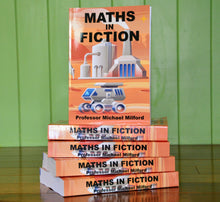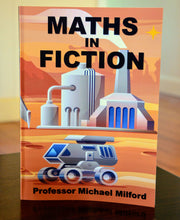Maths in Fiction Textbook
Regular price
$90.00
$81.00
Sale
This is a more comprehensive and much improved version of the original award winning resource, incorporating extensive feedback (both supportive and constructively critical) from students and teachers over the past 4 years. We are already getting some great feedback: this is what the Head of Mathematics at the first school to order the new version just said:
“I am so blown away!!! These books that arrived this morning are amazing! How exciting.”
The Maths in Fiction resource contains three main components, all linked to the Australian curriculum and all designed to excite and engage students in mathematics and STEM learning through fiction, movies, real life examples and fun scenarios:
- Young Adult Novel "Code Bravo" embedded inside the textbook, with 26 key mathematical scenarios and accompanying tutorials, real life examples, worksheets and worked solutions
- Maths in the Movies: 17 tutorials, worksheets and worked solutions covering scenarios often encountered in Hollywood movies including Mars Mission, Spaceship Adventure, Spider Superpowers, Speeding Bus, Runaway Train, Survival Competition, Giant Monsters, Fighter Jets, Climate Change Disaster, Comet Impact Disaster, Car Racing, Prisoner-of-War Camp Escape, Dinosaur Theme Park, Futuristic Superhero, Classic Adventure, Fishing Boat Storm and Plane Crash Landing.
- Thrillify Scenarios: 14 exciting math-filled scenarios including Stunt Person, Fashion Designer, Architect for Millionaires, Base Jumping, Luxury Car Dealer, Firefighter, Surviving the Wilderness, Hazardous Materials Expert, Social Media Star, Racing Car Driver, Runaway Plane, Self-driving Cars, Space Rescue Mission and Speed Record Setter.
Age range: 12 and upwards
FAQ and List of Major Changes and Improvements
How Can We Use the Maths in Fiction Resource?
There are lots of ways to incorporate the Maths in Fiction resource into your teaching. The first is to use the scenarios, tutorials and worksheets from the novel, maths in the movies or Thrillify sections to extend or enrich your normal curriculum coverage.
For example, you could spend a whole or partial lesson on the Maths in the Movies Mars Mission tutorial and worksheet when you are covering any of the following curriculum topics:
Curriculum Codes: ACMMG199 | ACMNA127 | ACMMG197 | ACMNA173 | ACMEM031 | ACMEM032
- Solve problems involving duration, including using 12 and 24hour time within a single time zone
- Find a simple fraction of a quantity where the result is a whole number, with and without digital technologies
- Investigate the relationship between features of circles such as circumference, area, radius and diameter. Use formulas to solve problems involving circumference and area
- Recognise and solve problems involving simple ratios
- Use units of energy to describe consumption of electricity, such as kilowatt hours
- Use units of energy used for foods, including calories
Another option is to work your way through the Code Bravo novel and associated 26 mathematical scenarios, tutorials, real life examples and worksheets. This is a genuine STEAM (Science Technology Engineering Arts and Mathematics) experience that could occur over an entire term or semester. You could even work closely with your English department to set it as a joint activity involving both book reading and mathematics.
What’s in the Novel?
The novel is a typical young adult novel with a young male and female protagonist. It contains plotlines, themes, action and some violence that is consistent with mass market young adult books. All content is presented to the standard or better of contemporary fiction: for example, children never kill anyone, let alone other children (unlike in some young adult fiction).
We have worked with a professional young adult writer to ensure action scenes and associated violence is presented wherever possible in terms of the emotional reactions of the characters and less so as explicit violence.
How Do You Deal with Mature Themes?
All explicitly educational material (tutorials, worksheets, worked solutions, real-life examples) has been revised to make it appropriate for a high school audience. This has involved both re-editing, and also completely new rewrites on new topics. Where appropriate, we make thematic substitutions in the educational material for content encountered in the fictional novel.
We have also intentionally embedded the novel in the textbook itself. This embedding reinforces the positive context of the scenarios, which all involve the protagonists using mathematics and STEM concepts to try and do good things within the story’s plotline.
Examples include:
- All explicitly educational material (not the novel itself) minimizes mentions or references to explicit violence or adult themes: there are no guns, bombs [1] and minimal reference to the possibility of death [2].
- In the fictional novel, the teenage protagonists (the heroes of the story) program and deploy a computer bot that earns money gambling online in order to pay an informant for life saving information: in the teaching materials, we remove the gambling reference by replacing it with an investment scenario.
- In the novel, there is an adult-only shoot out between the villains and the police involving speed of sound mathematics: in the teaching materials we completely replace this scenario with two examples involving the speed of sound of a starter’s gun during a running race and of lightning during thunderstorms.
- There are explosions in the fictional novel: all associated educational material deals with the calculations that miners must make when using blasting to excavate and open up new mine sites.
- While there are shoot outs in the fictional novel, all associated educational material uses content substitutions: in this case the hero trying to work out what angle to fire a grappling hook at in order to sneak into the back of a truck.
I Noticed That a Few of the Maths in the Movies Examples Are From M-rated Movies
All Maths in the Movies educational content only focuses on age-appropriate content or scenes from the movies. For example, in the tutorial on movies with speeding vehicles like a bus, we focus on the bus jump scenario (not the bomb or gunfights), and in the futuristic superhero movie tutorial we focus on the mathematics behind the self-driving trucks in the movie, a chase and on calculating the superhero's age (rather than the explicit fighting).
There is also no requirement to watch the movie referenced: the tutorials, worksheets and worked solutions are fully self-contained. You could also choose to just show the particular relevant segment from the movie if you wanted to provide some more context.
Striking the Right Balance Between Entertainment and Age Appropriate Content
Based on extensive feedback, discussion and consultation with students, teachers and educational experts, we believe we have got the balance right. We set out with this initiative to use the entertainment (movies and books) that students love to watch and read to help engage them in STEM learning. At the same time, we have an obligation to present material that is appropriate for a teenage audience.
Our approach is simple: use movies and create fiction that is consistent with what many teenagers already consume on a daily basis, and combine it with explicitly educational material (the tutorials, worksheets, real-life examples and solutions) that is age appropriate and which minimizes or removes potentially objectionable themes to the fullest extent possible without reneging on the initial premise.
[1] With the exception of our coverage of movies with speeding vehicles like a speeding bus, which is our most requested maths in the movie scenario of all time – in this case not mentioning the core plot device would be disingenuous, so we mention it but treat the topic delicately.
[2] With the exception of a statistical tutorial on improving medical health care, and our coverage of survival movie plots, which looks (sensitively) at concepts encountered in these storylines like a lottery that chooses who competes.
TedX Talk
Watch My Related TedX talk: How Hollywood can save math education







